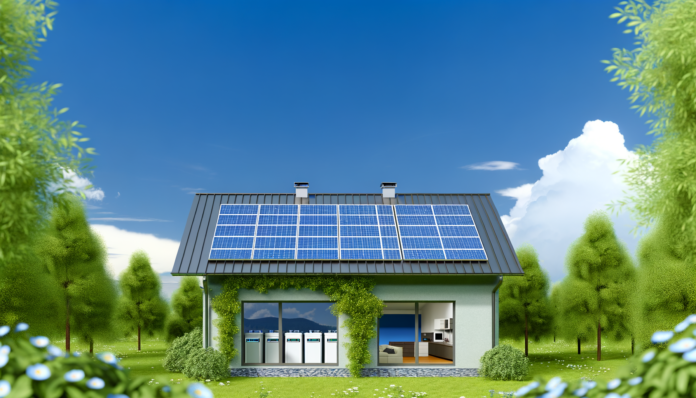Introduction
Overview of Solar Energy and Off-Grid Living
Solar energy has emerged as a leading renewable energy source, offering a sustainable and eco-friendly alternative to traditional fossil fuels. Harnessing the power of the sun, solar panels convert sunlight into electricity, providing a clean and renewable source of energy. This technology has become increasingly popular among homeowners and businesses alike, particularly in regions with abundant sunlight, such as Perth, one of the sunniest cities in the world.
Off-grid living, on the other hand, refers to a lifestyle where individuals or communities are not connected to the public electricity grid. Instead, they rely on self-sufficient energy systems, often incorporating solar power, to meet their electricity needs. This approach offers numerous benefits, including energy independence, reduced utility bills, and a smaller carbon footprint. However, it also requires careful planning and efficient energy management to ensure a reliable and consistent power supply.
Importance of Efficient Energy Management
Efficient energy management is crucial for maximizing the benefits of solar power, especially in off-grid settings. By optimizing the use of generated solar energy and minimizing waste, individuals can significantly enhance the return on investment (ROI) of their solar systems. Efficient energy management involves several key practices, including:
- Load Shifting: Utilizing solar energy during peak production hours and reducing reliance on the grid during off-peak times.
- Energy Storage: Implementing battery storage solutions to store excess solar energy for use during periods of low sunlight or high demand.
- Monitoring and Control: Using energy management systems (EMS) to monitor, regulate, and optimize energy consumption in real-time.
- Maintenance: Regularly inspecting and maintaining solar panels and related equipment to ensure optimal performance.
By adopting these practices, off-grid solar users can achieve greater energy efficiency, reduce costs, and contribute to a more sustainable future.
Purpose and Scope of the Article
The purpose of this article is to provide a comprehensive guide on maximizing your solar investment through efficient energy management in off-grid settings. We will explore various strategies and best practices to help you optimize the performance and ROI of your solar power system. The article is structured into several sections, each focusing on a specific aspect of solar energy management:
- Understanding Your Solar System: An overview of the key components of a solar power system, including solar panels, battery storage, and inverters.
- Optimizing Solar Panel Placement: Tips for assessing sunlight exposure, ideal angles and orientation, and avoiding shading and obstructions.
- Maximizing Energy Storage: Guidance on choosing the right battery type, proper maintenance, and using battery management systems.
- Efficient Energy Usage: Techniques for prioritizing essential appliances, energy-saving tips, and using smart home technology.
- Maintenance and Troubleshooting: Best practices for regular system inspections, cleaning, and identifying common issues.
- Future Trends and Innovations: Insights into advancements in solar technology, emerging battery technologies, and the future of off-grid living.
By the end of this article, you will have a thorough understanding of how to effectively manage your solar energy system, ensuring maximum efficiency and long-term sustainability. Whether you are a seasoned off-grid enthusiast or new to solar power, this guide will equip you with the knowledge and tools needed to make the most of your solar investment.
Understanding Your Solar System
Components of a Solar Power System
A solar power system is composed of several key components that work together to convert sunlight into usable electricity. The primary components include:
- Solar Panels: These are the most visible part of the system, responsible for capturing sunlight and converting it into direct current (DC) electricity.
- Inverter: This device converts the DC electricity generated by the solar panels into alternating current (AC) electricity, which is used by most household appliances.
- Battery Storage: Batteries store excess electricity generated during the day for use at night or during cloudy periods.
- Charge Controller: This component regulates the voltage and current coming from the solar panels to the batteries, preventing overcharging and prolonging battery life.
- Mounting System: This includes the racks and hardware used to secure the solar panels to your roof or ground installation.
Types of Solar Panels and Their Efficiency
Solar panels come in various types, each with different efficiency levels and characteristics:
- Monocrystalline Panels: Known for their high efficiency and sleek appearance, these panels are made from a single crystal structure. They typically offer efficiency rates between 15-20%.
- Polycrystalline Panels: These panels are made from multiple silicon crystals and are generally less efficient than monocrystalline panels, with efficiency rates ranging from 13-16%. However, they are more cost-effective.
- Thin-Film Panels: Made from a variety of materials, thin-film panels are flexible and lightweight but have lower efficiency rates, usually between 10-12%. They are often used in large-scale installations where space is not a constraint.
Battery Storage Options
Battery storage is crucial for off-grid solar systems, allowing you to store excess energy for use when sunlight is not available. The main types of batteries used in solar systems include:
- Lead-Acid Batteries: These are the most common and cost-effective option. They come in two types: flooded and sealed. Flooded lead-acid batteries require regular maintenance, while sealed ones are maintenance-free.
- Lithium-Ion Batteries: Known for their high efficiency, longer lifespan, and lighter weight, lithium-ion batteries are more expensive but offer better performance and require less maintenance.
- Flow Batteries: These are a newer technology that offers long cycle life and the ability to discharge completely without damage. They are ideal for large-scale storage but are currently more expensive and less common.
Inverters and Their Role
Inverters play a critical role in a solar power system by converting the DC electricity generated by the solar panels into AC electricity, which is used by most household appliances. There are several types of inverters:
- String Inverters: These are the most common type, connecting a series of solar panels (a string) to a single inverter. They are cost-effective but can be less efficient if one panel in the string is shaded or malfunctioning.
- Microinverters: These are installed on each solar panel, allowing for individual optimization and better performance in shaded conditions. They are more expensive but offer higher efficiency and flexibility.
- Hybrid Inverters: These inverters can manage both solar panel input and battery storage, making them ideal for systems that include energy storage solutions.
Understanding these components and their roles is essential for maximizing the efficiency and effectiveness of your solar power system. By selecting the right types of panels, batteries, and inverters, you can ensure that your system meets your energy needs and provides a reliable source of power for your off-grid living.
Optimizing Solar Panel Placement
Assessing Sunlight Exposure
Maximizing the efficiency of your solar panels begins with a thorough assessment of sunlight exposure. The goal is to ensure that your panels receive the maximum amount of sunlight throughout the day. Start by evaluating the location where you plan to install the panels. Use tools like solar pathfinders or online solar mapping services to analyze the sun’s path and identify the best spots for installation. **Key factors to consider include:**
– **Geographical Location:** The closer you are to the equator, the more sunlight you will receive year-round.
– **Local Climate:** Areas with frequent cloud cover or heavy rainfall may require more panels to achieve the same energy output as sunnier regions.
– **Time of Year:** Sunlight exposure varies with the seasons, so it’s essential to consider both summer and winter sun paths.
Ideal Angles and Orientation
The angle and orientation of your solar panels significantly impact their efficiency. Panels should be positioned to capture the most sunlight throughout the day. Here are some guidelines:
– **Orientation:** In the Northern Hemisphere, panels should face true south to maximize exposure. In the Southern Hemisphere, they should face true north.
– **Tilt Angle:** The optimal tilt angle depends on your latitude. A general rule of thumb is to set the tilt angle equal to your latitude. For example, if you are at 30 degrees latitude, your panels should be tilted at 30 degrees. Adjusting the tilt angle seasonally can further optimize performance:
– **Summer:** Decrease the tilt angle by 10-15 degrees to capture more sunlight.
– **Winter:** Increase the tilt angle by 10-15 degrees to capture lower-angle sunlight.
Avoiding Shading and Obstructions
Shading can drastically reduce the efficiency of your solar panels. Even a small amount of shade on a single panel can affect the entire system’s output. To avoid shading and obstructions:
– **Site Selection:** Choose a location free from trees, buildings, and other structures that could cast shadows on your panels.
– **Trim Trees:** Regularly trim any nearby trees that could grow and obstruct sunlight.
– **Panel Layout:** Arrange panels in a way that minimizes shading from other panels or mounting structures. Consider using microinverters or power optimizers to mitigate the impact of partial shading.
Seasonal Adjustments
Seasonal changes in the sun’s position require adjustments to maintain optimal panel performance. Here are some tips for seasonal adjustments:
– **Summer Adjustments:** During summer, the sun is higher in the sky. Lower the tilt angle of your panels to capture more direct sunlight.
– **Winter Adjustments:** In winter, the sun is lower in the sky. Increase the tilt angle to capture more sunlight at a lower angle.
– **Tracking Systems:** For those looking to maximize efficiency year-round, consider installing solar tracking systems. These systems automatically adjust the angle and orientation of the panels to follow the sun’s path, ensuring optimal exposure throughout the day and across seasons.
By carefully assessing sunlight exposure, optimizing angles and orientation, avoiding shading, and making seasonal adjustments, you can significantly enhance the efficiency and output of your solar panels. These steps are crucial for maximizing your solar investment and ensuring a reliable energy supply off the grid.
Maximizing Energy Storage
Choosing the Right Battery Type
Selecting the appropriate battery type is crucial for maximizing your solar investment. The most common types of batteries used in solar energy systems are lead-acid, lithium-ion, and saltwater batteries. **Lead-acid batteries** are cost-effective and have a long track record, but they require regular maintenance and have a shorter lifespan. **Lithium-ion batteries**, on the other hand, are more expensive but offer higher efficiency, longer lifespan, and require less maintenance. **Saltwater batteries** are an emerging technology that is environmentally friendly and safe, but they are less efficient and have a shorter lifespan compared to lithium-ion batteries. When choosing a battery, consider factors such as cost, efficiency, lifespan, and maintenance requirements to find the best fit for your needs.
Proper Battery Maintenance
Maintaining your batteries properly is essential to ensure their longevity and efficiency. Here are some key maintenance tips:
- Regular Inspections: Check your batteries regularly for any signs of wear, corrosion, or damage. Look for any leaks or bulging, which could indicate a problem.
- Cleaning: Keep the battery terminals clean and free from corrosion. Use a mixture of baking soda and water to clean the terminals if necessary.
- Temperature Control: Batteries perform best at moderate temperatures. Ensure your battery storage area is well-ventilated and protected from extreme temperatures.
- Charge Management: Avoid deep discharges and overcharging, as these can significantly reduce the lifespan of your batteries. Use a charge controller to manage the charging process effectively.
Energy Storage Capacity Planning
Proper planning of your energy storage capacity is vital to ensure you have enough stored energy to meet your needs. Here are some steps to help you plan effectively:
- Assess Your Energy Needs: Calculate your daily energy consumption by reviewing your electricity bills or using an energy monitor. This will help you determine how much energy you need to store.
- Consider Future Growth: Account for any potential increases in energy usage, such as adding new appliances or expanding your home. This will help you choose a battery system that can accommodate future needs.
- Evaluate Solar Production: Analyze your solar panel system’s energy production to understand how much excess energy you can store. This will help you determine the appropriate battery capacity.
- Plan for Autonomy: Decide how many days of autonomy you need, which is the number of days you want to rely on stored energy without solar production. This will help you calculate the total storage capacity required.
Using Battery Management Systems
A Battery Management System (BMS) is essential for optimizing the performance and lifespan of your batteries. A BMS monitors and manages the charging and discharging processes, ensuring your batteries operate within safe parameters. Here are some benefits of using a BMS:
- Enhanced Safety: A BMS protects your batteries from overcharging, deep discharging, and overheating, reducing the risk of damage and ensuring safe operation.
- Improved Efficiency: By balancing the charge across all battery cells, a BMS ensures optimal performance and maximizes the efficiency of your energy storage system.
- Extended Lifespan: Proper management of charging and discharging cycles helps extend the lifespan of your batteries, providing better returns on your investment.
- Real-Time Monitoring: A BMS provides real-time data on battery performance, allowing you to monitor energy storage levels, identify potential issues, and make informed decisions about energy usage.
By choosing the right battery type, maintaining it properly, planning your storage capacity, and using a Battery Management System, you can maximize your solar investment and ensure efficient energy management off the grid.
Efficient Energy Usage
Prioritizing Essential Appliances
When living off the grid, it’s crucial to prioritize the use of essential appliances to ensure that your solar energy is used efficiently. Focus on appliances that are necessary for daily living, such as refrigerators, water pumps, and lighting. Non-essential appliances, like entertainment systems or luxury items, should be used sparingly or during peak sunlight hours when your solar panels are generating the most energy. By prioritizing essential appliances, you can make sure that your energy consumption aligns with your energy production, thereby maximizing the efficiency of your solar system.
Energy-Saving Tips and Techniques
Implementing energy-saving techniques can significantly reduce your overall energy consumption, making your solar investment more effective. Here are some tips to help you save energy:
- Use energy-efficient appliances: Opt for appliances with high energy efficiency ratings, such as LED light bulbs and ENERGY STAR-certified devices.
- Load shifting: Run high-energy-consuming appliances like dishwashers and washing machines during the day when solar energy production is at its peak.
- Unplug devices: Disconnect chargers and electronics when not in use to avoid phantom loads.
- Insulate your home: Proper insulation can reduce the need for heating and cooling, thereby saving energy.
- Utilize natural light: Make the most of daylight by arranging your living spaces to maximize natural light, reducing the need for artificial lighting.
Monitoring and Managing Energy Consumption
Effective energy management starts with monitoring your energy consumption. By keeping track of how much energy you use and when you use it, you can make informed decisions to optimize your energy usage. Many solar systems come with monitoring software that provides real-time data on energy production and consumption. Use this data to:
- Identify high-energy usage periods: Adjust your habits to use less energy during these times.
- Detect inefficiencies: Spot appliances or systems that consume more energy than necessary and consider upgrading or replacing them.
- Plan energy usage: Schedule energy-intensive tasks during periods of high solar energy production.
Using Smart Home Technology
Smart home technology can play a significant role in managing and optimizing your energy usage. Devices such as smart thermostats, smart plugs, and energy management systems can help you control and monitor your energy consumption more effectively. Here are some ways to integrate smart technology into your off-grid solar system:
- Smart thermostats: Automatically adjust heating and cooling based on your schedule and preferences, reducing energy waste.
- Smart plugs: Control appliances remotely and set schedules to turn them off when not in use.
- Energy management systems: Monitor and manage your entire home’s energy usage, providing insights and recommendations for energy savings.
- Automated lighting: Use smart lighting systems that adjust based on occupancy and natural light levels.
By prioritizing essential appliances, implementing energy-saving techniques, monitoring your energy consumption, and utilizing smart home technology, you can maximize the efficiency of your solar investment and ensure a sustainable and comfortable off-grid living experience.
Maintenance and Troubleshooting
Regular System Inspections
Regular inspections are crucial to ensure your solar power system operates efficiently and reliably. Conducting periodic checks helps identify potential issues before they escalate into significant problems. Here are some key points to consider during inspections:
- Visual Inspection: Look for any visible damage to the panels, wiring, and mounting structures. Check for cracks, discoloration, or loose connections.
- Performance Monitoring: Use monitoring software to track the system’s performance. Sudden drops in energy production can indicate underlying issues.
- Component Check: Inspect inverters, batteries, and other components for signs of wear and tear. Ensure all parts are functioning correctly.
Regular inspections can help maintain optimal performance and extend the lifespan of your solar power system.
Cleaning and Upkeep of Solar Panels
Keeping your solar panels clean is essential for maximizing their efficiency. Dirt, dust, and debris can accumulate on the panels, reducing their ability to capture sunlight. Here are some tips for effective cleaning:
- Frequency: Clean your panels at least twice a year, or more frequently if you live in a dusty or polluted area.
- Tools: Use a soft brush, sponge, or cloth with water to gently clean the panels. Avoid abrasive materials that could scratch the surface.
- Safety: If your panels are on the roof, ensure you take proper safety precautions or hire a professional cleaning service.
Regular cleaning helps maintain the panels’ efficiency and ensures maximum energy production.
Identifying and Fixing Common Issues
Even with regular maintenance, issues can arise in your solar power system. Here are some common problems and their solutions:
- Shading: Ensure no new obstructions, such as growing trees, are casting shadows on your panels. Trim or remove any shading sources.
- Loose Connections: Check for and tighten any loose electrical connections. Loose connections can lead to power loss and potential safety hazards.
- Inverter Issues: If the inverter shows error messages or stops working, consult the user manual for troubleshooting steps or contact the manufacturer for support.
- Battery Problems: Monitor battery performance and ensure they are charging and discharging correctly. Replace batteries that show signs of degradation.
Addressing these issues promptly can prevent more significant problems and ensure your system operates smoothly.
When to Seek Professional Help
While regular maintenance and minor troubleshooting can be handled by homeowners, some situations require professional assistance:
- Complex Repairs: If you encounter issues beyond basic troubleshooting, such as significant electrical problems or component failures, it’s best to call a professional.
- Safety Concerns: Working with electrical systems can be dangerous. If you’re unsure about any aspect of the maintenance or repair process, seek professional help to avoid accidents.
- System Upgrades: For major upgrades or expansions, professional installers can ensure the new components integrate seamlessly with your existing system.
Professional help ensures that your solar power system remains safe, efficient, and reliable, providing you with peace of mind and optimal performance.
Future Trends and Innovations
Advancements in Solar Technology
The solar industry has seen remarkable advancements over the past decade, and this trend shows no signs of slowing down. **Perovskite solar cells** are one of the most promising developments. These cells offer the potential for higher energy yields and lower production costs compared to traditional silicon-based panels. Although not yet widely available, they are expected to become more accessible within the next few years.
Another exciting innovation is **transparent solar panels** and **solar shingles**. These technologies integrate seamlessly into building materials, providing aesthetic and functional benefits. Additionally, the efficiency of solar panels continues to improve, with top-tier models now achieving efficiencies above 20%. These advancements make solar energy more viable and cost-effective for off-grid living.
Emerging Battery Technologies
Battery storage is crucial for maximizing the benefits of solar energy, especially for off-grid systems. **Solid-state batteries** are emerging as a game-changer due to their higher energy density and safety compared to traditional lithium-ion batteries. These batteries promise longer lifespans and faster charging times, making them ideal for solar energy storage.
**Flow batteries** are another innovative solution. They offer the advantage of scalability and long-duration energy storage, which is particularly useful for off-grid applications. As these technologies mature, they will provide more reliable and efficient energy storage options, further enhancing the feasibility of off-grid solar systems.
Integration with Other Renewable Energy Sources
The future of off-grid living will likely involve the integration of multiple renewable energy sources. **Hybrid systems** that combine solar, wind, and even micro-hydro power can provide a more stable and reliable energy supply. These systems can be tailored to the specific environmental conditions of a location, ensuring optimal energy production year-round.
**Smart grids** and **microgrids** are also becoming more prevalent. These systems use advanced software and sensors to manage energy production and consumption efficiently. They can operate independently or connect to the main grid, providing flexibility and resilience in energy management.
The Future of Off-Grid Living
Off-grid living is evolving from a niche lifestyle choice to a viable option for many people, driven by advancements in technology and increasing environmental awareness. **Smart home technology** will play a significant role in this transition. Devices that monitor and manage energy consumption in real-time can help optimize the use of renewable energy sources, making off-grid living more convenient and sustainable.
**Government incentives** and **financial programs** are also making it easier for homeowners to invest in off-grid systems. Policies that support renewable energy adoption, such as tax credits and rebates, are expected to continue, further reducing the cost of going off-grid.
In summary, the future of off-grid living looks promising, with continuous advancements in solar technology, emerging battery solutions, and the integration of multiple renewable energy sources. These innovations will make off-grid systems more efficient, reliable, and accessible, paving the way for a more sustainable and independent lifestyle.






